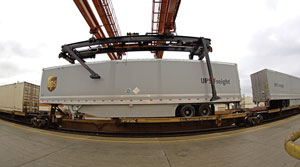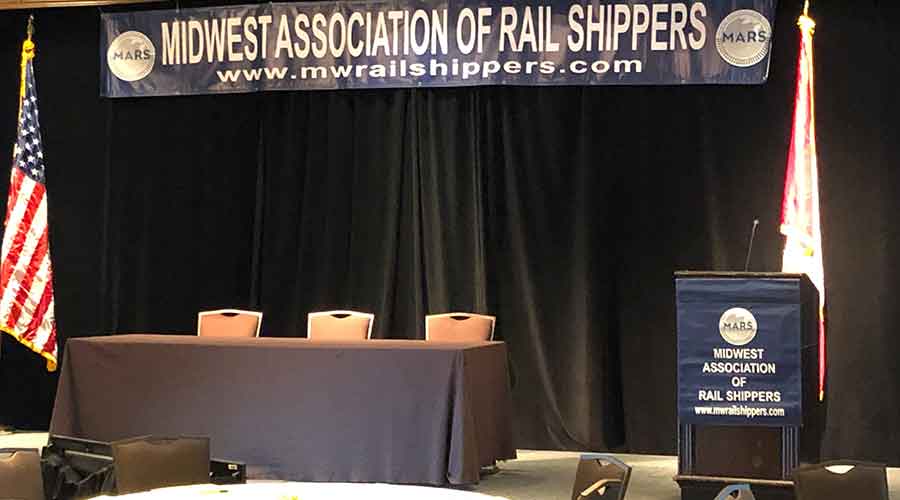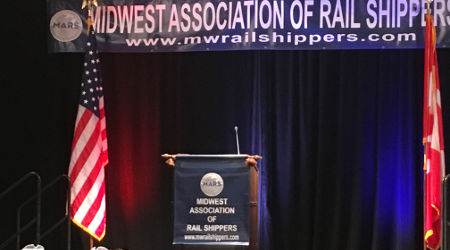Stay updated on news, articles and information for the rail industry
October 2008
Rail News: Shippers
Shippers Say 'Yea' to Rail Service, 'Nay' to Higher Rates
By Jeff Stagl, Managing Editor
Just a few years ago, shippers were irate about railroads’ congested networks and inconsistent transit times. Many reluctantly diverted their freight to trucks, the higher-priced transport option.
These days, shippers are finding railroads provide more consistent transit times and more available capacity. But a number of shippers again are grudgingly turning to trucks or other modes to move their freight. The reason: escalating rail rates.
Shippers’ thumbs up for rail service performance and thumbs down for rail rates — as well as the traffic-diversion and legislative-relief ramifications of those assessments — was readily apparent in an informal rail shipper survey Progressive Railroading conducted in August in conjunction with the National Industrial Transportation League (NITL), an association that represents the interests of more than 600 shippers.
NITL distributed the survey, which asked members to rate railroads’ service in 2008 and how it compared with service performance in 2007, and assess their rail rates vs. their expectations and ’07 prices.
Although the poll netted only 25 responses, the survey ratings and accompanying comments — as well as remarks made by shippers contacted by Progressive Railroading via phone or email — generally match what members are saying these days about rail service and rates, says NITL President Bruce Carlton. That is, transit times are good, but could always be better, and rate increases have reached unreasonable levels — in some cases, more than 10 percent.
Many of the survey respondents’ rate complaints can best be summarized as follows: We understand railroads are businesses that are trying to increase profits in the face of inflation and higher operating costs, but our rate increases exceed what would be considered a reasonable percentage and the railroads won’t tell us exactly why. So, we’ll use other modes when we can.
A food product shipper who responded to the survey believes railroads have a false perception that trucks and barges “can’t compete economically” with rail, while a chemical-shipping respondent said the long-term ramifications of high rail rates make trucking a more financially viable option.
Another overriding theme: respondents’ support for “re-regulation” bills to obtain rate relief.
“If a [rate] compromise plan isn’t accepted by shippers and railroads, then rail competition legislation must be pursued,” said a coal ores/aggregates shipper.
The long-running antagonistic relationship between railroads and shippers, and lack of frequent and constructive communication precludes the parties from understanding each other’s position, says Carlton.
“You look at trucking, and ocean and inland water freight, and air, and I perceive that between the transportation user and provider, there’s more cooperation, more give and take,” he says. “The two forces have a genuine interest to come together and find and define a workable partnership — but not in rail.”
Class I senior executives declined requests to discuss rates. But during second-quarter earnings conferences held in July, several chief executive officers stated that rate increases reflect what the market will bear and the value of the service provided, and help offset the cost of capacity expansion projects.
“We are going to proceed along the path of charging for the value of our service, and we think that’s a high value,” said Norfolk Southern Corp. Chairman, President and CEO Wick Moorman during the Class Is’ second-quarter earnings conference held July 23 in Norfolk, Va. “We think that we offer a superior alternative in the marketplace, and we will be trying to realize the value of that when we discuss rates with our customers.”
Not a quick fix
It’s evident there isn’t a one-size-fits-all or easy-to-come-by resolution to railroads’ and shippers’ rate differences.
At the very least, railroads and shippers need to come together a lot more often to better understand each others’ needs and wants, a few survey respondents said. They’re open to meetings that would transcend the occasional Association of American Railroads forums and face-to-face sales calls, and be in lieu of joint appearances at rate dispute proceedings before the Surface Transportation Board (STB) and congressional hearings on proposed “re-reg” legislation. It’s not as if shippers don’t want railroads to succeed, or vice versa, says Carlton.
“Railroads were in bad shape financially 15 years ago, and now they’re making record profits,” he says. “The question is this: Is there an appropriate model for sustainability of the Class Is in which shippers don’t feel like they’re being held up? I guess it depends where you sit.”
Where shippers sit is a desire for rates that reasonably reflect economic and market conditions, and service that’s extremely reliable. Survey results show shippers view rates as anything but “reasonable.”
Among the 25 respondents, 11 said their rates were “slightly unfair” and seven said they were “very unfair.” Six respondents said their rates were “acceptable” and one said rates were “marginally fair.” In addition, 16 said their rates had gone up more than 5 percent, eight said their rates had risen less than 5 percent and one said their rate was the same.
Among comments as to why rates were higher than last year and what railroads could do to provide reasonable rates, the respondents said:
- “Railroads don’t want to talk about ‘reasonable’ rates.”
- “Rates are higher because they are imposing their monopoly power.”
- “The railroads continue to force increases on shippers where there is no competitive access, well beyond the 180 percent revenue-to-variable cost threshold because they will gamble that we won’t take them to the STB.”
- “Railroads do not need to just pass along blanket rate increases, they need to evaluate the origin-destination pairs that do not move freight and ask themselves if the reason is because the rate is not competitive with the market.”
However, one respondent said “reasonable” is in the eye of the beholder.
“My preference obviously would be to have the railroads reduce our rates right now, but that would be an unrealistic expectation,” said the chemical shipper. “So long as increases do not exceed the inflation rate, I deem them acceptable.”
Another chemical-shipping respondent, who agreed to talk anonymously by phone, said his interpretation of “unreasonable” is this: Railroads are re-establishing their cost models to account for escalating fuel expenses, causing shippers to pay twice for fuel, via higher rates and separate fuel surcharges.
“They tell us they crunch the numbers, and this is what it is, take it or leave it,” said the shipper, who moves about 8,000 carloads via rail annually. “Our rates have risen about 10 percent the past year.”
Market dictates rates
During the Q2 earnings conferences, several Class I senior execs said railroads are not double-dipping by factoring
diesel-cost increases into rate hikes as well as assessing fuel surcharges. But shippers should expect rate increases — perhaps in the 5 percent-to-6 percent range — because that’s what the market bears, especially since trucking costs have shot up along with diesel prices and some shippers have had “good deals” for years, the execs said.
“In the ag business, quite honestly, it’s just the strength of the market that’s allowed us to go in [and raise rates],” said Union Pacific Railroad Executive Vice President of Marketing and Sales Jack Koraleski during the Class I’s second-quarter earnings conference held July 24 in Omaha, Neb. “Whereas typically, we might take one or two price increases over the course of a year, we’ve been able to do three or four.”
Responding to a question posed the same day at BNSF Railway Co.’s Fort Worth, Texas, earnings conference about whether the railroad can increase its baseline pricing above 6 percent reached in the second quarter because of high fuel prices and the number of shippers who are rethinking their freight movement and logistics management strategies, Chairman, President and CEO Matthew Rose said the Class I would maintain its “historically strong pricing going forward.”
“We’re very proud of the pricing performance we have had over the last several years and see no reason why we can’t continue to move forward in the range of where we’ve been,” said Rose.
How much is too much?
Another survey respondent reached by phone can think of one. The chemical shipper, who requested anonymity, has heard and disputes the “what the market will bear” and “gotten good deals for years” arguments from railroads.
“I could make the same arguments for my business,” said the shipper, who moves about 12,000 carloads via rail annually. “How much does the rate go up before you say, ‘I’m going to ship it another way.’ It doesn’t feel like a partnership, so what incentive do I have to switch to rail? A railroad sales guy comes in here and asks what they have to do to convert my freight to rail — why would I?”
However, another chemical-shipping respondent contacted via email said if you do your homework and share your market concerns on a micro-basis with railroads, you will be heard and sometimes accommodated — even though questions about how rate increases are calculated and why railroads aren’t interested in competing with one another are “met with a shrug by rail salespeople.”
“We evolved from the ‘wholesale bitching, how can you do this?’ response to a specific, ‘here’s our situation and what you’ve done for our competitor and how it is hurting us’ approach,” said the shipper, who also requested anonymity. “We focus on one or two moves, and take our medicine on the rest. If we can, we try to bundle some traffic to wring a modification on the [rate] increase.”
Although the NITL-assisted survey and follow-up interviews solicited a number of criticisms about rail rates, respondents provided almost as many compliments about rail service.
Among the 25 respondents, 14 rated railroads’ service performance as “good,” nine said it was “fair,” one said it was “excellent” and only one said it was “below average.” Comparing this year’s service with last year’s performance, 12 respondents said it was “slightly better,” 10 said it was “the same,” two said it was “worse” and one said it was “much better.”
Commenting on why they thought rail service had improved or what railroads could do to improve their performance, respondents said:
- “More available capacity has improved reliability and velocity.”
- “We have noticed less logjams on the rail system this year vs. last year.”
- “Less bottleneck pressure due to capital investments by carriers and a downturn in the economy.”
- “The western carriers are slightly better because of improvements in their switching and blocking of trains.”
- “Better local service at receivers.”
There also were some criticisms aimed at rail service, including:
- “I think the railroads generally try to resolve customer issues and did a great job during the floods this year, but it is not uncommon to have a car sit for almost a week waiting to get switched to another railroad.”
- “They need to create a schedule and stick to it — if the shipper/consignee is not ready, then move on.”
- “Carriers are good at moving road trains but lousy at local pick-up and delivery.”
- “We experience an unacceptably high number of errors on freight invoices. While this is not necessarily considered ‘rail service,’ it is part of the rail shipping process and one that really need to be worked on.”
- “Reducing transit time variability would be a welcome improvement.”
NS, for one, is trying to do just that. The Class I has increased its focus on not just running trains better, but providing consistent service, says NS Assistant VP of Customer Service Rush Bailey.
“If we say we will deliver a car on Thursday, we’ll deliver it on Thursday,” he says. “It’s important to not be too late or too early.”
The Class I has developed “valid” transportation plans for each shipment, tightened service metrics to measure execution and — for the first time — tied compensation to service performance, he says.
Performance tied to pay
Earlier this year, NS launched the compensation/service performance program for all non-agreement and some agreement personnel. The railroad developed a composite service metric incorporating train performance, connection performance and plan adherence, and created a scale with a range of compensation tied to the composite metric’s performance, says Bailey.
“It focuses attention on service and makes people more aware of why it matters,” he says.
NS also tightened the parameters of certain performance measures, so a train that arrives early is “considered a service failure now,” says Bailey.
In addition, the railroad in April launched Thoroughbred Pacesetter, an e-commerce service that enables shippers to directly manage their freight-car orders and releases, trace cars through the car pipeline and obtain detailed local car inventory information. Thoroughbred Pacesetter users receive service-based demurrage, which links service performance to demurrage credits — a rail industry first, according to NS.
“Shippers get the same vision of each car that we get internally,” says Bailey. “They get extra credit days if we don’t perform.”
NS had planned to cover 20 percent of its customer base with Thoroughbred Pacesetter by year’s end, but the Class I already reached that goal in September, he says. The Class I now plans to cover half the base sometime next year.
NS has noticed one lingering service-related effect from the days of inconsistent transit times and network congestion — shippers are holding onto rail cars, says Bailey.
“We weren’t delivering on a consistent basis, so customers are hoarding equipment,” he says. “We want to maximize our assets, and we can’t do that if we’re inconsistent.”
Several survey respondents mentioned tight rail-car supplies as a top service concern.
Two grain shippers said: “We have had more difficulties securing rail cars from the railroads’ fleets;” and “The lack of rail cars on the railroad fleet has become a very serious issue this year. We have had many hundreds of tons of materials that had to go by truck because the railroads were unable to supply equipment.”
Although grain-car supplies are tight, they’re manageable, said a grain shipper contacted by email.
“We have been forewarned about tightening supplies, but have easily managed to secure cars for all of our incoming requirements,” said the shipper, who requested anonymity. “Some of this hand wringing results in a self-fulfilling prophecy. There also seems to be a degree of pre- and over-ordering of equipment to ensure availability.”
High anxiety
It appears shippers’ hand wringing over certain rail service concerns, and primarily over the rail rate issue, will continue. And nervous shippers could prove troublesome to railroads.
An unrelenting stance on rate increases ultimately could lead railroads to a place they don’t want to go: Congress, where legislation — namely the Railroad Competition and Service Improvement Act (H.R. 2125/S. 953) and Railroad Antitrust Enforcement Act (H.R. 1650/S. 772) — could pass muster, forcing roads to lower some of their rates to below-market levels or enabling shippers to seek legal recourse for “anti-competitive” conduct, one survey respondent warned.
“Unless the railroads stop the ‘arrogance’ in rate negotiations and assessment of accessorial charges, they will be re-regulated in the next 10 years,” said the respondent, a grain/grain mill product shipper.
Although the recent financial market bailout and related economic crisis have dropped transportation a few notches on Congress’ urgency meter, the “re-reg” legislation might pick up steam again sometime after the new Administration takes office. In the meantime, it would behoove railroads to make more of an effort to understand and address their customers’ rate concerns, says NITL’s Carlton.
“The two sides need to get together and find an acceptable work-out,”
he says. 


 LRW Honors Amtrak’s Acheson As Railway Woman Of The Year
LRW Honors Amtrak’s Acheson As Railway Woman Of The Year
 From Editor-In-Chief Foran: Of Gender Equity And Inclusion
From Editor-In-Chief Foran: Of Gender Equity And Inclusion
 Spotlight On Some Of Today’s Rail Safety Products
Spotlight On Some Of Today’s Rail Safety Products
 Women of Influence in Rail eBook
Women of Influence in Rail eBook
 railPrime
railPrime






